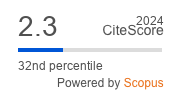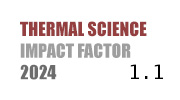THERMAL SCIENCE
International Scientific Journal
Thermal Science - Online First
online first only
Thermal comfort in typical seasons of summer and winter in personnel intensive areas of underground public buildings of Xi'an in China
ABSTRACT
Understanding the thermal comfort of densely populated areas in underground buildings is more significance. This paper takes two typical densely populated areas of underground buildings in Xi'an as examples, conducts questionnaire surveys and field tests on their thermal comfort. The results showed that in winter and summer, the frequency of thermal sensation of underground commercial buildings is higher than that of underground subway platforms, while not much difference in wet sensation and wind speed sensation. The thermal neutral operating temperature for underground commercial buildings in summer and winter is 27.1ºC and 20.2ºC. The thermal neutral operating temperature for underground subway platforms in summer and winter are 26.7ºC and 21.8ºC. The expected indoor temperature for underground commercial buildings in summer and winter is 26.6ºC and 19.2ºC. The expected indoor temperatures for underground subway platforms in summer and winter are 25.2ºC and 20.6ºC. It provides reference value for the creation of thermal environment in densely populated areas of underground buildings.
KEYWORDS
PAPER SUBMITTED: 2025-03-21
PAPER REVISED: 2025-06-27
PAPER ACCEPTED: 2025-06-30
PUBLISHED ONLINE: 2025-08-02
- Cao, L., Chong, P., Exploring the low-carbon development path of resource-based cities based on scenario simulation. Scientific Reports, 15, (2025), 1, pp. 5836
- Mostofa, R.A., et al., ‘GenUrban: Shaping cities for all genders'-Right to the city planning framework, Hong Kong. Cities, 150, (2024), pp. 105081
- Xie, H., et al., Exploring the Evolution Mechanisms of Social Risks Associated with Urban Renewal from the Perspective of Stakeholders. Buildings, 14, (2024), 5, pp. 1470
- Chen, X., et al., Simultaneous construction of subways and utility tunnels: A case project in Shenzhen, China. Tunnelling and Underground Space Technology, 158, (2025), pp. 5106421
- Asbach, C., et al., Evaluation of a Partector Pro for atmospheric particle number size distribution and number concentration measurements at an urban background site. Aerosol Research, 2, (2024), 1, pp. 1-12
- Lin, D., et al., Underground space utilisation and new town development: Experiences, lessons and implications. Tunnelling and underground space technology, 119, (2022), pp. 104204
- Li, J., et al., Comparative studies on the ventilation performance and obstacle deflection effect of attached ventilation in underground generator halls. Building and Environment, 274, (2025), pp. 112730
- Lan, X., et al., Study on the Destabilisation Pattern and Volumetric Water Content Evolution Characteristics of Underground Mining Rock Formations Under Heavy Rainfall Conditions. Water, 17, (2025), 2, pp. 20734441
- Mi, H., et al., The Influence of Vertical Greening Systems on Building Energy Consumption and Comprehensive Carbon Emission. Buildings, 15, (2025), 3, pp. 471
- Weng, M., et al., Optimization of airflow organization in the passenger cabin of special vehicles based on human thermal sensation. Case Studies in Thermal Engineering, 65, (2025), pp. 105678
- Li, S., et al., Human genetics identify convergent signals in mitochondrial LACTB-mediated lipid metabolism in cardiovascular-kidney-metabolic syndrome. Cell Metabolism, 37, (2025), 1, pp. 154-168
- Hong, X., et al., Spatial performance evaluation and optimization of integrated aboveground and underground spaces in urban commercial complexes. Journal of Asian Architecture and Building Engineering, 24, (2025), 2, pp. 623-649
- Dong, X., et al., Effect of thermal, acoustic, and lighting environment in underground space on human comfort and work efficiency: A review. Science of The Total Environment, 786, (2021), pp. 147537
- Pan, R., Hou, Z., The relationship between objective overqualification, perceived overqualification and job satisfaction: employment opportunity matters. Personnel Review, 53, (2024), 8, pp. 1925-1949
- Yu, W., et al., Spatiotemporal dynamics and determining factors of intercity mobility: A comparison between holidays and non-holidays in China. Cities, 153, (2024), pp. 105306
- Xu, X., et al., Short-term passenger flow prediction during station closures in subway systems. Expert Systems with Applications, 236, (2024), pp. 121362
- Park, S.J., et al., Nationwide distribution and factors related to indoor fine particulate matter concentrations in subway stations in Korea: Results of first-year measurement. Environment International, 193, (2024), pp. 109078
- Kim, K., et al., Revitalizing subterranean spaces: a comprehensive study on enhancing air quality in underground shopping malls for sustainable urban living. Sustainable Environment Research, 34, (2024), 1, pp. 25
- Hong, X., et al., Spatial performance evaluation and optimization of integrated aboveground and underground spaces in urban commercial complexes. Journal of Asian Architecture and Building Engineering, (2024), pp. 1-27
- Gao, K., et al., Ensuring accurate microclimate research: How to select representative meteorological data of local climate in microclimate studies. Building and Environment, 267, (2025), pp. 112166
- ASHRAE Standard 55-2020, Thermal Environmental Conditions for Human Occupancy, American Society of Heating, Refrigerating, and Air-Conditioning Engineers, Inc., Atlanta. 2020
- GB/T18883-2022; Standards for indoor air quality. State Administration for Market Regulation, Standardization administration of the People's Republic of China: Beijing, China, 2022
- Song, W.J.; Calautit, J.K., Inclusive comfort: A review of techniques for monitoring thermal comfort among individuals with the inability to provide accurate subjective feedback. Building and Environment, 257, (2024), pp. 111463
- D.A. MacIntyre, translated by Long Weiding et al., Indoor Climate, Shanghai Science and Technology Press, 1988
- Kalmár, T., et al., Comparative analysis of energy demand at an equal operative temperature in the case of radiator and low-temperature radiant heating. Journal of Building Engineering, 100, (2025), pp. 111792
- Wang, H., et al., A comprehensive evaluation index for indoor thermal comfort and energy utilization. Case Studies in Thermal Engineering, 63, (2024), pp. 105335
- Tetiranont, S., et al., Enhancing sustainable railway station design in tropical climates: Insights from Thailand's architectural theses and case studies. Buildings, 14, (2024), 3, pp. 829
- GB 9672-1996; Hyginic standard for waiting room of public transit means, China National Bureau of Technical Supervision: Beijing, China, 1996
- Holmberg, A., et al., General somatic health and lifestyle habits in individuals with obsessive-compulsive disorder: an international survey. BMC psychiatry, 24, (2024), 1, pp. 98
- Li, Q. Study on the thermal comfort of public underground space. Master's Thesis, Xi'an University of Architecture and Technology, Xi'an, China, 2015. (In Chinese)
- Niu, N., et al., Drip molding process of PCM for improving thermal and moisture comfort of thermal protective clothing. International Journal of Thermal Sciences, 196, (2024), pp. 108709

